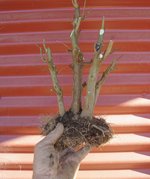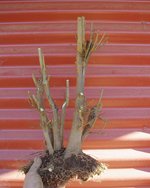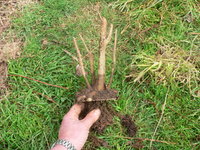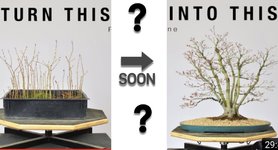Njyamadori
Chumono
I thought something like that would take 50-60 years instead since how far apart those are . But I can’t wait to see !here's my current method, but it'll be about 5-6 years before I can report back with results:
I thought something like that would take 50-60 years instead since how far apart those are . But I can’t wait to see !here's my current method, but it'll be about 5-6 years before I can report back with results:
It'll definitely be much longer than 5 years before it's anything worth looking at, but I'm hoping for a fused root base by then.I thought something like that would take 50-60 years instead since how far apart those are . But I can’t wait to see !
Roots look a little disproportionate to the trunksAll 2020, airlayering zelkova
View attachment 356375







Ahhhh all I needed to do was turn my phone upside down!View attachment 356378
It should be OK. And.. This is not the final size. There are a few years of growing out to do!!
Bjorn didn’t mention any of that in his video, you should try his wire tourniquet methodI get good results by threading seedlings through holes in metal plate.
View attachment 356390View attachment 356391View attachment 356392View attachment 356393View attachment 356394View attachment 356395View attachment 356396
Fusion is quick and permanent when the callus caused by the trunks swelling in the holes meet.
New roots are always horizontal across the plate.
New roots are usually right round the perimeter but sometimes I get one sided roots.
Trunk development is the biggest failure factor. Clumps look best with the central tree larger and thicker but outer trees frequently get larger as they have access to more resources. Need to monitor through the development process.
Direction of trunks is important. Try to arrange all trunks moving out from the centre from the start. Intervene with spacers or pruning where one or more trunks are leaning in undesirable direction because after they thicken and fuse it is hard to move them.
Multi trunk is not as easy as it appears. All trunks need to have good taper. All trunks need different size and thickness in proportion. All trunks need to conform in shape and lean. Branches then need to be in the right places on those trunks.
If you have tried to develop a single trunk and been frustrated because one or more factors don't come together then multiply that difficulty factor by the number of trunks in the clump to gauge how difficult clump style can be. My advice is start several to allow for the higher failure rates.

Thanks for the pointer. I have been there and done that. Maybe Bjorn should try my method?Bjorn didn’t mention any of that in his video, you should try his wire tourniquet method
Great! I will set a reminder to access your progress resource on the EarthWeb via my Trinity-Link™ cranial implant in 2041!I’m trying to get sango kaku seedlings for a clump since that would just look amazing . Also still looking for kishu or iotgawa. I’m gonna try the wire and tube method today and wait 20+ years lol. I really like @Shibui method since those trees are more of a forest with amazing nebari . I like Bjorns tree and he started when he was around my age when he did.
Sorry...need my coffee. Misread that.I’m trying to get sango kaku seedlings for a clump since that would just look amazing . Also still looking for kishu or iotgawa. I’m gonna try the wire and tube method today and wait 20+ years lol. I really like @Shibui method since those trees are more of a forest with amazing nebari . I like Bjorns tree and he started when he was around my age when he did.
Were these the 2 or 4 inch pots originally? Do you think it matters either way? ThanksActually...it will be 2 years fall 2021. I didn't assemble this until fall. Though it arrived as 5 cuttings spring that year.
Thanks. I'm contemplating an order and was hoping to better visualize the sizes offered.Gosh...I really can't say. I don't remember. But concept is the same. Image of the five cuttings.
View attachment 381450
